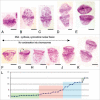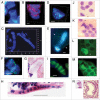Metakaryotic stem cell lineages in organogenesis of humans and other metazoans
- PMID: 20539738
- PMCID: PMC2878747
- DOI: 10.4161/org.5.4.9632
Metakaryotic stem cell lineages in organogenesis of humans and other metazoans
Abstract
A non-eukaryotic, metakaryotic cell with large, open mouthed, bell shaped nuclei represents an important stem cell lineage in fetal/juvenile organogenesis in humans and rodents. each human bell shaped nucleus contains the diploid human DNA genome as tested by quantitative Feulgen DNA cytometry and fluorescent in situ hybridization with human pan-telomeric, pan-centromeric and chromosome specific probes. From weeks approximately 5-12 of human gestation the bell shaped nuclei are found in organ anlagen enclosed in sarcomeric tubular syncytia. Within syncytia bell shaped nuclear number increases binomially up to 16 or 32 nuclei; clusters of syncytia are regularly dispersed in organ anlagen. Syncytial bell shaped nuclei demonstrate two forms of symmetrical amitoses, facing or "kissing" bells and "stacking" bells resembling separation of two paper cups. Remarkably, DNA increase and nuclear fission occur coordinately. Importantly, syncytial bell shaped nuclei undergo asymmetrical amitoses creating organ specific ensembles of up to eight distinct closed nuclear forms, a characteristic required of a stem cell lineage. Closed nuclei emerging from bell shaped nuclei are eukaryotic as demonstrated by their subsequent increases by extra-syncytial mitoses populating the parenchyma of growing anlagen. From 9-14 weeks syncytia fragment forming single cells with bell shaped nuclei that continue to display both symmetrical and asymmetrical amitoses. These forms persist in the juvenile period and are specifically observed in bases of colonic crypts. Metakaryotic forms are found in organogenesis of humans, rats, mice and the plant Arabidopsis indicating an evolutionary origin prior to the divergence of plants and animals.
Keywords: human; metakaryote; metakaryotic cells; metazoans; organogenesis; stem cell lineage; stem cells.
Figures






Similar articles
-
Mutator/Hypermutable fetal/juvenile metakaryotic stem cells and human colorectal carcinogenesis.Front Oncol. 2013 Oct 29;3:267. doi: 10.3389/fonc.2013.00267. Front Oncol. 2013. PMID: 24195059 Free PMC article. Review.
-
Metakaryotic stem cell nuclei use pangenomic dsRNA/DNA intermediates in genome replication and segregation.Organogenesis. 2014 Jan 1;10(1):44-52. doi: 10.4161/org.27684. Epub 2014 Jan 13. Organogenesis. 2014. PMID: 24418910 Free PMC article.
-
Human fetal/tumor metakaryotic stem cells: pangenomic homologous pairing and telomeric end-joining of chromatids.Cancer Genet Cytogenet. 2010 Dec;203(2):203-8. doi: 10.1016/j.cancergencyto.2010.08.015. Cancer Genet Cytogenet. 2010. PMID: 21156234 Free PMC article.
-
Bell-shaped nuclei dividing by symmetrical and asymmetrical nuclear fission have qualities of stem cells in human colonic embryogenesis and carcinogenesis.Cancer Genet Cytogenet. 2006 Jan 1;164(1):16-24. doi: 10.1016/j.cancergencyto.2005.05.005. Cancer Genet Cytogenet. 2006. PMID: 16364758
-
Stem cell stages and the origins of colon cancer: a multidisciplinary perspective.Stem Cell Rev. 2005;1(3):243-51. doi: 10.1385/SCR:1:3:243. Stem Cell Rev. 2005. PMID: 17142861 Review.
Cited by
-
Nuclear morphologies: their diversity and functional relevance.Chromosoma. 2017 Mar;126(2):195-212. doi: 10.1007/s00412-016-0614-5. Epub 2016 Sep 8. Chromosoma. 2017. PMID: 27631793 Free PMC article. Review.
-
Mutator/Hypermutable fetal/juvenile metakaryotic stem cells and human colorectal carcinogenesis.Front Oncol. 2013 Oct 29;3:267. doi: 10.3389/fonc.2013.00267. Front Oncol. 2013. PMID: 24195059 Free PMC article. Review.
-
Arterial calcification: Finger-pointing at resident and circulating stem cells.World J Stem Cells. 2014 Nov 26;6(5):540-51. doi: 10.4252/wjsc.v6.i5.540. World J Stem Cells. 2014. PMID: 25426251 Free PMC article. Review.
-
Metakaryotic stem cell nuclei use pangenomic dsRNA/DNA intermediates in genome replication and segregation.Organogenesis. 2014 Jan 1;10(1):44-52. doi: 10.4161/org.27684. Epub 2014 Jan 13. Organogenesis. 2014. PMID: 24418910 Free PMC article.
-
Human fetal/tumor metakaryotic stem cells: pangenomic homologous pairing and telomeric end-joining of chromatids.Cancer Genet Cytogenet. 2010 Dec;203(2):203-8. doi: 10.1016/j.cancergencyto.2010.08.015. Cancer Genet Cytogenet. 2010. PMID: 21156234 Free PMC article.
References
-
- Gostjeva EV, Zukerberg L, Chung D, Thilly WG. Bell shaped nuclei dividing by symmetrical and asymmetrical nuclear fission have qualities of stem cells in human colonic embryogenesis and carcinogenesis. Cancer Genet Cytogenet. 2006;164:16–24. - PubMed
-
- Gostjeva EV, Thilly WG. Stem cell stages and the origins of colon cancer: a multi-disciplinary perspective. Stem Cell Rev. 2005;1:243–252. - PubMed
-
- Wilson EB. The Cell in Development and Inheritance. New York, MacMillan: 1896.
-
- Child CM. Amitosis as a factor in normal and regulatory growth. Anat Anz. 1907;30:271–297.
-
- Stough HB. Further studies of modified mitosis. J Morphol. 1935;58:221–256.
LinkOut - more resources
Full Text Sources
Other Literature Sources
